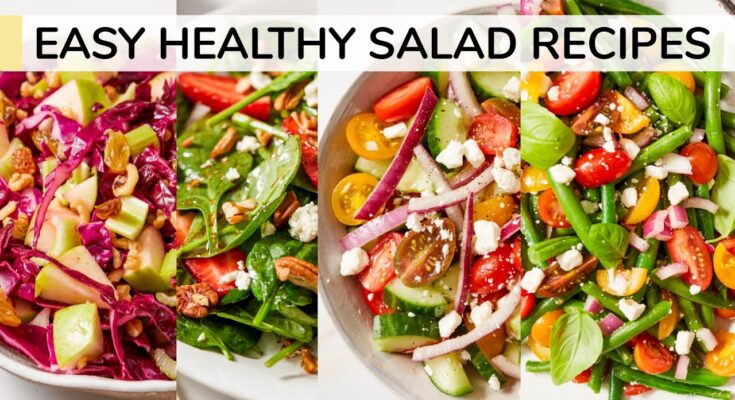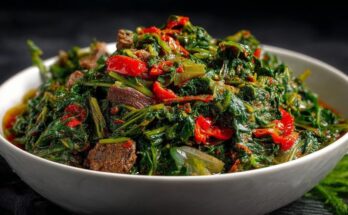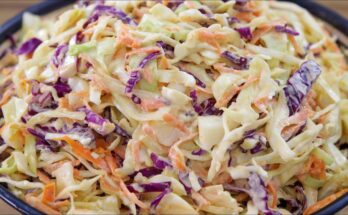Salad Recipe: Salads are a universal favorite, loved for their versatility, simplicity, and health benefits. Whether you’re looking for a quick meal, a side dish, or a nutrient-packed option for weight management, salads have got you covered.
Packed with vitamins, fiber, and antioxidants, they’re a delicious way to boost your daily intake of veggies and fruits while keeping things light yet satisfying.
Types of Salads
Vegetable Salads
Vegetable salads are a classic choice, featuring fresh, raw vegetables like lettuce, spinach, kale, cucumbers, carrots, and bell peppers. You can add shredded cabbage for a crunch or throw in some cherry tomatoes for a burst of sweetness.
Fruit Salads
Fruit salads are sweet and refreshing, perfect as a side dish or dessert. Popular combinations include apples, grapes, strawberries, and a drizzle of honey or lime juice to elevate the flavor.
Protein-Based Salads
Adding grilled chicken, boiled eggs, chickpeas, or tofu can turn a basic salad into a hearty and protein-rich meal. These salads are ideal for post-workout meals or as a filling lunch.
Grain Salads
Incorporating grains like quinoa, couscous, or wild rice can make your salad more filling. These grains pair well with roasted veggies and a tangy dressing.
Tools and Ingredients You’ll Need
Essential Salad-Making Tools
To make the perfect salad, you’ll need:
- A sharp knife for chopping
- A large salad bowl for tossing
- A vegetable peeler for thin slices
- Salad spinner to dry greens efficiently
Choosing Fresh Ingredients
Always opt for fresh, seasonal produce. Fresh greens like spinach or romaine lettuce, ripe fruits, and crisp vegetables enhance both the flavor and texture of your salad.
Step-by-Step Salad Recipe Guide
Step 1: Select Your Base
Start with a base that fits your mood. Greens like spinach, arugula, or romaine lettuce provide a classic option. If you’re in the mood for something heartier, try quinoa or couscous.
Step 2: Add Fresh Vegetables
Chop fresh vegetables into bite-sized pieces. Carrots, cucumbers, and bell peppers are great for a crunchy texture, while tomatoes add juiciness.
Step 3: Add Protein
Protein is what makes your salad a complete meal. Grill some chicken, roast chickpeas, or add a boiled egg to pack in essential nutrients and flavor.
Step 4: Incorporate Healthy Fats
Healthy fats not only add richness but also help absorb vitamins. Avocado slices, a sprinkle of nuts, or seeds like chia and sunflower elevate the salad’s nutritional profile.
Step 5: Toss in Fruits
To balance the savory elements, add some sweetness with fruits like oranges, apples, or even dried cranberries.
Step 6: Add a Crunchy Element
The crunch factor is key. Toasted croutons, roasted nuts, or crispy onions add an exciting contrast of texture.
Step 7: Create Your Dressing
A simple vinaigrette can be made by whisking olive oil, lemon juice, and Dijon mustard. For a creamy dressing, mix yogurt, garlic, and herbs.
Step 8: Toss and Serve
Finally, toss all the ingredients gently to ensure the dressing is evenly distributed. Serve immediately to enjoy the freshest taste.
Tips for Perfect Salads
Balancing Flavors
A great salad has a balance of sweet, salty, tangy, and spicy. Experiment with ingredients like honey, sea salt, balsamic vinegar, and chili flakes.
Presentation Matters
Use colorful ingredients and layer them neatly. A vibrant salad is not only appetizing but also visually appealing.
Storage Tips
If preparing salads in advance, store the dressing separately to prevent soggy greens. Use airtight containers to keep ingredients fresh.
Popular Salad Variations
Classic Caesar Salad
Romaine lettuce, croutons, Parmesan cheese, and Caesar dressing make this timeless favorite.
Greek Salad
Combine cucumbers, tomatoes, onions, olives, and feta cheese, topped with olive oil and oregano.
Caprese Salad
Tomatoes, fresh mozzarella, and basil leaves drizzled with balsamic glaze make this simple yet elegant dish.
Asian-Inspired Salad
Mix cabbage, carrots, and greens with a sesame-soy dressing for a bold, tangy twist.
FAQs about Salad Recipes
1. What are some easy salad recipes for beginners?
For beginners, simple and quick salad recipes are best. Start with a basic garden salad including mixed greens, cherry tomatoes, cucumbers, and a simple vinaigrette. Another easy recipe is a Greek salad, which involves tomatoes, cucumbers, red onion, feta cheese, olives, and a dressing of olive oil and lemon juice.
2. How can I make my salads more flavorful?
Enhance the flavor of your salads by incorporating a variety of textures and tastes such as nuts, seeds, herbs, spices, and different types of cheese. Dressings also play a crucial role; try making your own with ingredients like balsamic vinegar, honey, mustard, or fresh herbs.
3. What are some healthy dressing options?
Healthy dressing options include olive oil and vinegar, lemon juice and herbs, yogurt-based dressings, or avocado blended with lime and cilantro for a creamy yet nutritious choice.
4. Can salads be a full meal?
Yes, salads can definitely be a full meal. To make a salad more filling, add protein sources like grilled chicken, tofu, or beans, and starchy components like quinoa or roasted sweet potatoes.
5. How do I store a prepared salad to keep it fresh?
To store a salad and keep it fresh, keep the dressing separate until you are ready to eat. Store the salad in an airtight container in the refrigerator. For best results, add any crunchy or protein components just before serving to maintain their texture.
6. What are some uncommon but tasty ingredients to add to a salad?
Try adding roasted nuts, dried fruits like cranberries or apricots, grains like farro or barley, or even grilled fruits like peaches or pineapple for a unique twist on traditional salads.
Conclusion
Salads are a blank canvas for creativity and flavor. Whether you’re in the mood for something light or hearty, there’s a salad recipe for every occasion. Experiment with different ingredients, flavors, and textures to create your perfect bowl.



